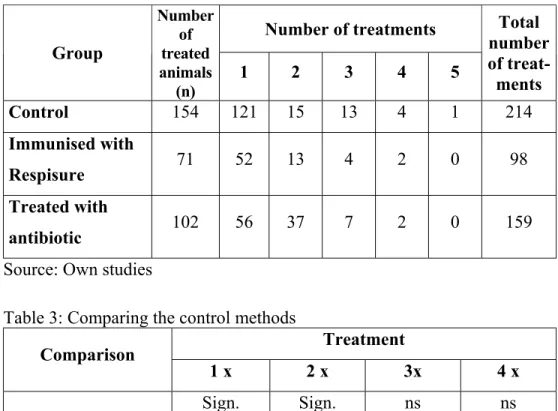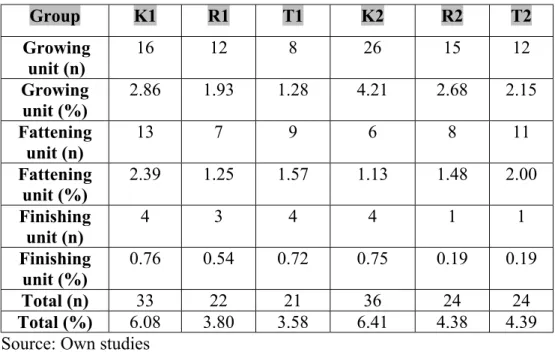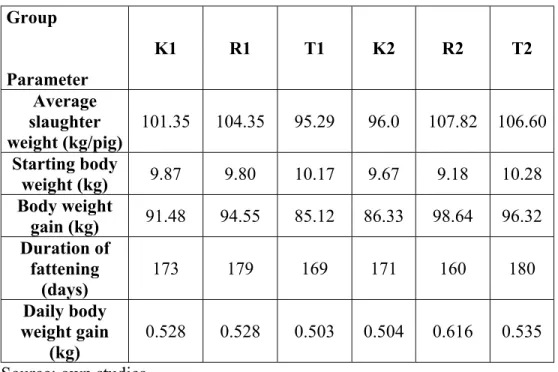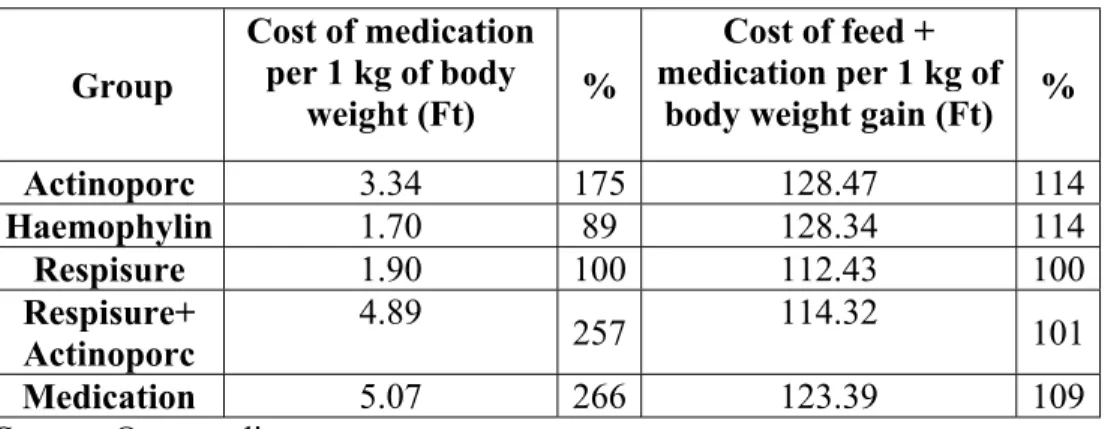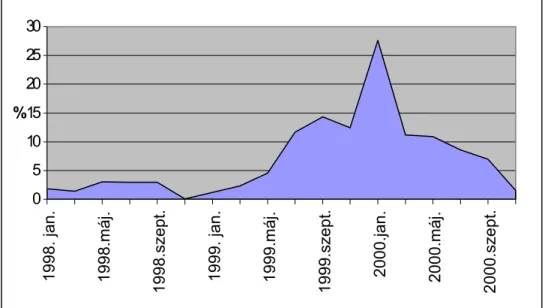UNIVERSITY OF WESTERN HUNGARY FACULTY OF AGRICULTURE AND FOOD SCIENCE DEPARTMENT OF AGRICULTURAL ECONOMICS AND
MARKETING
Project Leader: Supervisor:
Dr. Dr. h. c. János Iváncsics Dr. Antal Tenk
Professor Professor
D. Sc. (Doctor of the HAS) Candidate of Agricultural Sciences
INFLUENCE OF HYGIENIC MANAGEMENT ON THE EFFICIENCY OF PORK PRODUCTION
Written by:
Dr. Tamás Abonyi
Mosonmagyaróvár 2002
1. ANTECEDENTS AND OBJECTIVES
The change of political and economic system that took place in 1989- 1990 brought many changes in the Hungarian agriculture. Overall, this transformation had a greater impact on the animal production sectors than on plant cultivation. While the importance of products of animal origin in the global food supply steadily increased, in Hungary the consumption of foods of animal origin substantially decreased from the early 1990s, narrowing down the domestic market of animal products.
The factors contributing to the critical situation that emerged in the pig production sector are rather complex. An important factor is that the quality of the products fails to meet the requirements posed by the changed conditions. The good health status of herds is a factor crucial for turning out good-quality, export-oriented and, thus, competitive products. Keeping losses to the minimum as well as identifying and rapidly eliminating the major sources of losses are essential for the farms in order to ensure the profitability of production.
With a view to our eagerly expected EU membership, our current level of competitiveness is well illustrated by the fact that, of the present EU member states, only Spain and Portugal have a lower output of fattening pigs per sow than Hungary. Countries with highly developed pig production have an advantage of 4–6 fatteners per sow on a year basis in this index as compared to Hungary.
In such a situation, all animal health interventions and disease control measures that can increase the annual output of fattening pigs per sow should be implemented.
There are two major areas in which substantial improvement must, and can, be achieved. One is improvement of the reproductive indices and the other is using all reasonable and economical means to protect the piglets already born and to reduce the losses.
As Hungary is currently free of the highly contagious infectious diseases causing huge economic losses, attention is mostly focused on infectious diseases that decrease the profitability of production, which diseases are well known also in countries with highly developed pig production. Usually two main categories of disease are mentioned in this regard: respiratory and enteric diseases.
This dissertation discusses the economic aspects of controlling the respiratory disease complex, a disease entity causing huge economic losses in the everyday farm practice of pig production by giving rise to substantial mortality, emergency slaughter and reduced feed conversion rate. Within this rather complex subject, the correlations between the respiratory disease complex of swine and the efficiency of pork production, as well as the differences in the economic efficiency of various control measures against respiratory diseases were studied in detail.
The choice of subject is justified by the following factors:
(1) The respiratory disease complex has become widespread all over the world and causes huge losses.
(2) Its diagnosis is easy, relatively cheap and simple (e.g. by the inspection of lungs at the slaughterhouse).
(3) The literature contains accurate figures on the magnitude of losses caused by the disease complex and on the methods of assessing those losses.
(4) We can choose between two different approaches of control: treatment of diseased pigs or prevention of the development of the disease by vaccination or antibiotic treatment. Both approaches are widely used also in Hungary.
(5) The increasing aversion of consumers to the antibiotic content of meat and meat products.
(6) Control by immunisation is less expensive than the renovation of technological equipment or the reconstruction of buildings.
Starting from the factors listed above, the dissertation studies the following objectives and possible solutions:
(1) Determination of the prevalence of respiratory disease complex in the Hungarian pig population.
(2) The magnitude of losses caused by the disease (in quantitative and qualitative terms).
(3) How (to what extent) does the “homogeneous immune status produced by immunoprophylaxis” influence the efficiency of production under the current management conditions?
(4) Effect of different methods of controlling diagnosed respiratory disease on the efficiency of production.
(5) What increase in average daily body weight gain and what improvement in feed conversion rate is needed to compensate for the extra costs of immunoprophylaxis incorporated in the management technology?
2. INVESTIGATIONS AND METHODS APPLIED
The investigations and their results are based on case studies conducted at different farms over a period of several years. Although the studied questions are different, they are consistent and complementary to one another.
The objective of the investigations carried out in Case study no. 1 was to determine whether vaccination against mycoplasmosis has any economic advantage over the traditional treatment (administration of antibiotics in the feed), under the same conditions of management.
Objective: to study the effects of antibiotic treatment and immunisation, with especial regard to the efficiency of fattening.
Relying on the experience gained in Case study no. 1, Case study no.
2 was aimed at determining the economic effects of one or two vaccinations with Respisure, and of different antibiotic treatment strategies, under the same conditions of management and keeping.
Objective: to compare the economic results of different disease control strategies.
Case study no. 3 already involved the study of different vaccinations against several other pathogens implicated in the aetiology of respiratory disease complex of swine, as well as of the effectiveness of antibiotics mixed in the feed, under farm conditions, without changing the applied management technology, on the basis of economic variables. As these trials
were of farm scale, no control group (untreated animals) was used in this study.
Objective: to determine the method of prevention that gives the best economic results on herd level.
Case study no. 4 was devoted to studying porcine circovirus infection that had recently emerged in Hungary. The development of, and the economic losses caused by, porcine circovirus infection combined with respiratory mycoplasmosis were studied, together with the possibility of preventing this disease by Respisure vaccination.
Objective: to minimise the losses occurring among weaned piglets in the rearing facility.
Selection of the statistical methods applied:
The data derived from the different case studies were evaluated by the methods presented below.
In Case study no. 1 the health status of animals in the different groups, the number of individual treatments becoming necessary, and the number and cause of deaths were studied. Parallel to this, the body weight of the pigs was determined at 40 days of age and at the end of fattening, and the quantity of feed consumed was recorded on a continuous basis to determine the feed conversion rate. The data obtained during the studies were pre- arranged and then processed statistically:
- by comparison on a percentage basis,
- by contingency analysis, determination of Pearson’s χ2 value and calculation of Yates’ correction parameters,
- by significance calculations, and - by Pearson’s and Yates’ χ2 tests.
In Case study no. 2, the starting point was the average litter weight determined by individual weighing of the weaned piglets. Individual weighing carried out at the end of growing, fattening and finishing provided another average value. Within this study, the respiratory organs of 120 pigs per group were inspected after slaughter at the slaughterhouse, with especial regard to the occurrence of pleuropneumonia. The S-EUROP grading data of the slaughtered pigs were also recorded and analysed statistically.
Statistical evaluation of the results of this study was done - by calculation of the means and standard deviations, - by calculation of the coefficient of variation, and - by comparison on a percentage basis.
Studies performed in Case study no. 3 provided data on the preventive and therapeutic treatment of the groups, the causes of mortality and the number of deaths, the quantity of feed consumed, the status of respiratory organs of slaughtered animals as revealed by inspection at the slaughterhouse, and on the prevalence and severity of pleuropneumonia.
Statistical evaluation of these data was done
- by calculation of the means and standard deviations, - by calculation of the coefficient of variation, and - by comparison on a percentage basis.
Case study no. 4 compared the status of the examined herd in the post- weaning period after the introduction of vaccination with its previous (nonvaccinated) status, with particular regard to the time-course and the peak of mortality.
Mortality occurring at a time which was found in this study to be critical for the success of vaccination, at an identical age, was evaluated statistically by the calculation of percentages.
3. MAIN RESULTS OF THE STUDY
The basic question of studies on the mortality and culling rates was how much these events could be attributed to respiratory or enteric problems. The relevant basic data obtained in Case study no. 1 are presented in Table 1. The values shown in the table indicate that the lowest mortality rate (4.8%) was found in the herd vaccinated with Respisure.
Table 1: Mortality and culling rates in the different groups Mortality and culling Due to
respiratory problems
Due to enteric problems
Mortality and culling, total Group
Starting number
(n)
n % n % n %
Control 148 27 18.2 8 5.4 35 23.2
Respisure 125 6 4.8 9 7.2 15 12.0
Antibiotic 143 25 17.5 10 7.0 35 24.5
Source: Own studies
The studies also extended to determining the number of individual treatments becoming necessary. As it can be seen from the data of Table 2, the lowest number of individual treatments was needed in the group vaccinated with Respisure.
Table 2: Number of individual treatments in the different groups Number of treatments Group
Number of treated animals
(n)
1 2 3 4 5
Total number of treat-
ments
Control 154 121 15 13 4 1 214
Immunised with
Respisure 71 52 13 4 2 0 98
Treated with
antibiotic 102 56 37 7 2 0 159
Source: Own studies
Table 3: Comparing the control methods
Treatment Comparison
1 x 2 x 3x 4 x
Control/Respisure Sign.
p<0,001
Sign.
p<0,01
ns p=0,05
ns p=0,05 Respisure/Antibiotic ns
p=0,05
Sign.
p<0,01
ns p=0,05
ns p=0,05 Source: Own studies
There was significantly less need for treatment once or twice in the Respisure vaccinated, group then in control group. Only the two times treated animals showed significant difference towards those of the antibiotic treated ones.
The most important indicator of the success of disease control is the number and severity of lung lesions seen at the slaughterhouse.
Table 4: Percentage comparison of the results of different control methods Lung score, % Pleura score, %
Control 139 109
Immunised with
Respisure 100 100
Treated with
antibiotic 121 100
Source: Own studies
Taking as 100% the value of Respisure vaccination which gave the most favourable results, all other disease control procedures proved be less effective (Table 4).
Taking into account the results thus obtained, for the 1000-sow unit of the farm used in Case study no. 1 the extent of possible performance improvement was calculated, in the case of 2.2 litters per sow per year.
According to the results of this calculation, the following improvement of efficiency can be expected if Respisure vaccination is introduced on farm level:
1. Cost savings from treatments rendered unnecessary:
Savings: 1.000.000 Forints
2. Increased production results due to the reduction of mortality of
respiratory origin: 14.664.000 Forints
(Piglet losses decrease by 2948 piglets; 20 kg/piglets, 150 Forints/kg).
3. Increased slaughter weight: 2 kg/pig, at a price of 300 Forints/kg:
13.200.000 Forints 4. Result realised from the 10.5% increase of the feed conversion rate:
35.000.000 Forints
Increased result, total: 66.864.000 Forints Cost of vaccination (44,000 doses of Respisure): 12.320.000 Forints The above figures show that the farm in question could have realised excess sales revenues of 54,544,000 Forints in 2001. The increase of financial result per fattening pig is 2479 Forints. Taking the cost of vaccine as an investment, the invested amount would bring a 4,4 times rate of return in one year.
Case study no. 2 studied the effect of different disease control methods on the number of deaths and the mortality rate.
Table 5: Mortality found in the different groups
Group K1 R1 T1 K2 R2 T2
Growing unit (n)
16 12 8 26 15 12 Growing
unit (%)
2.86 1.93 1.28 4.21 2.68 2.15
Fattening unit (n)
13 7 9 6 8 11
Fattening unit (%)
2.39 1.25 1.57 1.13 1.48 2.00
Finishing
unit (n) 4 3 4 4 1 1
Finishing unit (%)
0.76 0.54 0.72 0.75 0.19 0.19
Total (n) 33 22 21 36 24 24
Total (%) 6.08 3.80 3.58 6.41 4.38 4.39
Source: Own studies
In this trial, both antibiotic treatment (T1, T2) and control by vaccination (R1, R2) decreased the mortality rate by approx. 30% as compared to the control (K1, K2) (Table 5).
The increase of the daily body weight gain, which manifests itself in the economic results (profits), was even more important (Table 6).
Table 6: Total daily body weight gain of the different groups Group
Parameter
K1 R1 T1 K2 R2 T2
Average slaughter weight (kg/pig)
101.35 104.35 95.29 96.0 107.82 106.60 Starting body
weight (kg) 9.87 9.80 10.17 9.67 9.18 10.28 Body weight
gain (kg) 91.48 94.55 85.12 86.33 98.64 96.32 Duration of
fattening (days)
173 179 169 171 160 180
Daily body weight gain
(kg)
0.528 0.528 0.503 0.504 0.616 0.535 Source: own studies
The data presented in Table 6 indicate that Group R2, i.e. the pigs immunised twice with Respisure, had the highest slaughter weight, the highest body weight gain, the highest daily weight gain, and the shortest fattening period. The minimal CV% value, calculated from the average slaughter weight and deviation, was given by the data of the animals
immunised twice with Respisure. That showed the homogeneity of the vaccinated group.
The pigs immunised twice with Respisure had the lowest number of pulmonary lesions and these animals were the healthiest.
From the results of Case study no. 3, the daily weight gains and feed conversion rates achieved by the different disease control methods should be highlighted (Table 7).
Table 7: Percentile comparison of the results obtained Control method Body weight gain
(daily)
Feed conversion rate (kg/kg)
Respisure 672 g 100.00% 3.28 100.00%
Actinoporc 610 g 90.77% 3.71 113.10%
Haemophylin 577 g 85.86% 3.76 114.63%
Respisure+
Actinoporc 647 g 96.27% 3.23 98.47%
Medication 647 g 96.27% 3.49 106.40%
Source: Own studies
The comparison of data shows that pigs immunised with Respisure produced the highest daily body weight gain, but their feed conversion rate was 1.53% poorer than that of pigs receiving the Respisure-Actinoporc combined vaccination. Taking the cost of Respisure vaccination as 100%, the cost of this dual vaccination is 257% (Table 8).
Table 8: Investment and financial results Group
Cost of medication per 1 kg of body
weight (Ft) %
Cost of feed + medication per 1 kg of
body weight gain (Ft) %
Actinoporc 3.34 175 128.47 114
Haemophylin 1.70 89 128.34 114
Respisure 1.90 100 112.43 100
Respisure+
Actinoporc
4.89
257 114.32
101
Medication 5.07 266 123.39 109
Source: Own studies
This series of studies also proves that antibiotic therapy is expensive and increases the food safety risks (due to the residues possibly present).
In terms of the reduction of respiratory surface damage that can be achieved by the different disease control methods, the best results were obtained in pigs immunised with Respisure (Table 9).
Table 9: Lung lesions found at the slaughterhouse
Lung lesions found at slaughter (%) Group Negative Mild Moderate Severe Pleuritis
Actinoporc 56 28 12 4 22
Haemophylin 40 30 19 11 16
Respisure 65 21 9 5 6
Respisure+
Actinoporc 65 15 15 5 16
Medicated 53 29 14 4 22
Source: Own studies
In summary, it can be established that immunisation with Respisure is the most cost-effective method of control.
The main objective of Case study no. 4 was to determine whether the losses caused by circovirus infection (complicated by mycoplasmosis) that occurred in March 1999 could be reduced by Respisure vaccination. The first results of vaccination carried out in March 2000 could be seen already in May-June of that year. By the end of the year the mortality rate of weaned piglets returned to the level typical of the previous year (1998) (Fig. 1).
0 5 10 15 20 25 30
1998. jan. 1998.máj. 1998.szept. 1999. jan. 1999.máj. 1999.szept. 2000.jan. 2000.máj. 2000.szept.
%
Figure 1: Total postweaning piglet losses from January 1998 to November 2000
Source: Own studies
It can be established that in cases of circovirus infection in which Mycoplasma hyopneumoniae is the most important secondary pathogen, the high mortality of respiratory origin can be prevented by Respisure vaccination.
4. NEW OR NOVEL FINDINGS OF THE DISSERTATION
The fundamental aim of animal production is to ensure that healthy and efficiently producing animals raised on the best possible feed and posing no food safety risks are processed by slaughterhouses and meat processing plants operating under hygienic conditions into final products of the highest possible quality that meet the ever stricter demands of consumers and customers. Only an activity relying on such principles can provide perspectives for pork production in Hungary.
Based also on the results of the four case studies presented in the dissertation, full observance of the following factors is needed for meeting these requirements:
4.1. Efficient pork production is not possible without regular inspection at the slaughterhouse.
In Hungary, the possibilities provided by slaughterhouse inspection are underestimated even today. It is essential that seemingly healthy animals sent for slaughter from the farms are evaluated, in addition to the usual aspects of meat inspection, also according to the presence of lesions produced by different diseases having the greatest impact on profitable production.
4.2. Efficient pork production is not possible without the regular reporting of slaughterhouse findings back to the farm.
Veterinarians responsible for large pig farms should also carry out inspections of the final product at the slaughterhouse at regular intervals.
Even if this is not possible, the regular feedback of information, i.e. the reporting of slaughterhouse findings back to the farm, must be ensured. The situation could be improved substantially if stable seller groups were formed, as the common interest thus created would help ensure systematic and regular feedback of information.
4.3. Efficient pork production is not possible without the on-farm evaluation of regularly received slaughterhouse findings.
It can be seen from the results of the case studies that the on-farm evaluation of results received from the slaughterhouse is an important responsibility of the farm management. This evaluation is necessary for identifying the critical points and setting the tasks to be performed.
4.4. There is no solution of universal validity: the control plan must always be tailored to the farm in question.
On the basis of the investigations performed and possibly after having consulted an external expert, the veterinarian draws up a plan of the changes to be made. It is important to take into account the local conditions: in this case it must be carefully determined when the stock to be reared becomes infected, and with what pathogens.
4.5. Only immunoprophylaxis can guarantee profitable animal production.
Existence of a homogeneous immune status of herd level is a basic precondition of profitable production.
In the absence of such homogeneous immune status, diseases of varying severity can always occur, increasing the costs and reducing the profitability of production.
4.6. The specialists responsible for the management of the farm (animal breeder, veterinarian) can make an accurate cost-benefit analysis of the measures taken after the specific decisions only by working together and by complementing each other’s knowledge.
Managing a livestock farm is teamwork in the true sense of the word.
All people taking part in this work can address the emerged problems and retrospectively evaluate or alter the outcome of specific decisions only by working together and complementing each other’s technical knowledge.
Such collaboration is especially important in farms where the shortcomings of the management technology favour the development of different diseases of complex aetiology. On such farms it is the veterinarian’s responsibility to diminish the losses to the greatest possible extent.
4.7. Antibiotics administered in the feed are not only expensive but also increase the food safety risk and may preclude the possibility of export.
As sick animals eat little, they will not get from the feed the antibiotic dose required for their body weight. As a result, the therapeutic drug levels will not be attained in the organism, and thus the risk of antibiotic resistance development will dramatically increase.
4.8. During the short time remaining until Hungary’s accession to the European Union we must reach, or at least come close to, the standard of our competitors, as overproduction existing in the EU may knock down the domestic prices and lead to the failure of the Hungarian pork production sector.
The Hungarian pork production cannot be competitive in a situation when the daily body weight gain is 20–30% lower than that typical of our competitors. Only value-added products free of any animal health concerns may be sold on the internal market of the EU member states.
5. POSSIBILITIES OF USING THE STUDY RESULTS IN THE PRACTICE
5.1. The method presented in the dissertation makes it possible to determine accurately the losses of respiratory origin occurring in the Hungarian pig farms.
The method does not require financial investment and is easy to implement. It should become a routine procedure. The method of evaluation has been elaborated, and the losses can be expressed in numerical terms easily and rapidly on the basis of the data presented in the literature. From the results of the studies it appears that approx. 25% of the fattening pigs reared on large pig farms in Hungary show pulmonary lesions on herd level.
The lag in daily body weight gain is approx. 85 grams per fattening pig per day.
5.2. Only immunoprophylaxis can provide a method of respiratory disease control conforming to the farm conditions and the management technology applied.
The findings of the case studies presented in the dissertation prove that missed or delayed interventions increase the risks and adversely affect the results of production. Immunoprophylaxis results in lifelong protection and lung lesions are found in less than 5% of the vaccinated pigs on the average. As a result of the 20% decrease in the prevalence of lung lesions, the body weight gain increases by 70 grams per day.
5.3. The control of respiratory disease complex should be based on immunisation against Mycoplasma hyopneumoniae.
Numerous authors cited in the dissertation agree that Mycoplasma hyopneumoniae is the most important causative agent of the respiratory disease complex of swine, and colonisation of the lungs by that pathogen is responsible for the development of severe pneumonia. If mycoplasmosis is controlled by the use of an adjuvanted vaccine, the other secondary pathogenic agents will also be prevented from causing damage. The overall result is the above-mentioned approx. 70 g/day increase of body weight gain per fattener. Already a daily body weight gain increase of a few grams would cover the cost of even the most expensive and effective adjuvanted vaccine, and the reduced use of antibiotics would increase food safety.
5.4. Before judging the price of one dose of vaccine and evaluating the investment per fattening pig, we should always calculate the predicted benefit by taking into consideration the farm-adapted and slaughterhouse examinations, the results of clinical observations and gross pathological examinations made on the farm and the typical production indices of the farm.
The simple calculation presented in the dissertation can be recommended for the preparation of sound decisions. Using the farm’s own data in the calculation, a prognosis can be made on the predicted production results.
5.5. In cases when a farm becomes infected with circovirus, and circovirus infection is complicated by respiratory disease complex, the most expedient solution is the use of an Ampigen adjuvanted vaccine against Mycoplasma hyopneumoniae.
On the basis of the presented data of literature, postweaning multisystemic wasting syndrome (PMWS) of swine, caused by porcine circovirus, is a disease that occurs all over the world and gives rise to severe losses. Postweaning piglet mortality may reach 13–15%. In this study, the mortality rate of vaccinated piglets fell below 1%, i.e. to the level typical of the period preceding circovirus infection. This is an outstanding result with a view to the profitability of the farm.
5.6. In repopulated pig farms, already the piglets born from the first farrowing must be immunised against mycoplasmosis.
Newly populated farms are characterised by favourable production indices. All possible means must be employed to prevent the premature biological “exhaustion” of the farm and to keep the production indices on the initial high levels.
Also the findings of this study showed that the initially good results of the farm in question deteriorated substantially within one year, and after the identification of the problem it took another year before the farm results were restored to their original high level. However, this latter approach is uneconomical and endangers the profitability of pork production.
6. SCIENTIFIC PUBLICATIONS AND CONFERENCE PAPERS WRITTEN ON THE SUBJECT OF THE DISSERTATION
1. Abonyi, T., Körmendy, B., Vörös, K. 1994: Clinical and laboratory diagnosis of paratuberculosis in cattle. In: Proceedings of the 18th World Buiatrics Congress, Bologna, Italy.
2. Abonyi, T., Vörös, K., Kökény, G., Kiss, T., Gyulay, Gy. 1988: Az oltógyomor helyzetváltozás felderítésére alkalmazott klinikai szűrővizsgálatok és a műtéti gyógykezelés gazdasági haszna egy tejelő tehenészetben [Clinical screening tests for the diagnosis of abomasal dislocation and the economic benefits of surgical management in a dairy herd]. Magyar Állatorvosok Lapja 43: 3, 177–181.
3. Molnár, T., Selmeczi, Cs., Szentirmai, I., Abonyi, T. 1999: A sertések légzőszervi betegségei elleni védekezés lehetőségei [Possibilities of controlling respiratory diseases of swine]. A Sertés 4: 2, 22–24.
4. Abonyi, T., Kántás, K., Vörös, K., Avas, Á. Lymphoid leucosis előfordulása sertésben – klinikai és kórbonctani vizsgálatok [Lymphoid leucosis in swine] Magyar Állatorvosok Lapja 1987. 42.
10. 591-595.
5. Abonyi, T. 2000: A sertések légzőszervi betegségkomplexének korszerű management-je [Up-to-date management of the respiratory disease complex of swine]. MÁK [Hungarian Veterinary Chamber].
Training Course, Gödöllő.
6. Abonyi, T. 2002: A sertések légzőszervi betegségkomplexének korszerű management-je [Up-to-date management of the respiratory disease complex of swine]. MÁK [Hungarian Veterinary Chamber].
Training Course, Sárvár.
7. Abonyi, T. 1986-2002: A sertések légzőszervi betegségei [Respiratory diseases of swine]. SZIE ÁTK (Szent István University, Faculty of Veterinary Science, Budapest).

